|
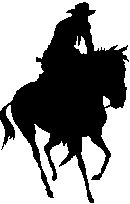
March-May 2007
|
BLACK
HORSE EXTRA
Detectives in Cowboy Boots
Hoofprints Ending with a Bang
Farewell to a Small Giant
New Black
Horse Westerns
One year when sales of western novels hit a worrying low, a publisher
advised a contributor, "If an author has confidence in his writing ability
he should tackle something more demanding than the short western, and certainly
from Elmore Leonard onwards there are writers who have made a successful
transition."
He was partly wrong and partly right. Done properly -- with attention
to the standards of plotting, characterization, background research and
narrative skill that should apply to all genres -- the western is as "demanding"
as any other fiction, maybe more so when it comes to achieving the delicate
balance between historical reality and myth. He was right with his mention
of Elmore Leonard. He might also have named Erle Stanley Gardner, John D.
MacDonald, John Jakes and Loren D. Estleman among others, though the crossovers
have not always been in one direction.
Traditionally, advances on westerns have averaged less than novels in other
categories. Reports today are that a publisher will pay four times what he
pays for a western for a historical romance. Granted the latter, with similar
research demands and similar calls for set-piece scenes, will run to more
pages, though not four times as many, and will carry a higher cover price,
though not four times higher.
Just as galling is the notion buyers of hardcover and trade-paperback westerns,
usually public libraries, don't give a hoot for the credentials of individual
writers; that they buy by publisher's imprint and price. The readers of
westerns, it's alleged, are too shy to communicate preferences, or don't
have them.
In this issue, we can read Chap O'Keefe's memories of authors who moved
competently between thriller and western fiction and whose books were widely
enjoyed. A second feature provides useful research information on a firearm
popular with western writers -- the Walker Colt. Sift through the legends
and the facts with Greg Mitchell.
Enjoy, too, the Hoofprints section, and
feel free to leave your own impressions at feedback@blackhorsewesterns.com.
Lastly, sadly, we must mark the passing of writer Sydney J. Bounds -- a grand
old man of genre fiction (and Black Horse Westerns) who died in late
November.
|
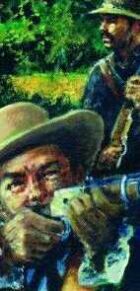
|
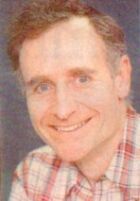
|
Chap
O'Keefe on writers who ride for two brands
DETECTIVES IN COWBOY BOOTS
Where was Emily Greatheart? The pretty young lady from Denver had gone to Arizona to meet her dead fiancé's mother
and vanished. Only a bloodstained jacket was found in an abandoned spring buggy hired from the Pike's Crossing livery stable.
Emily was the daughter
of Big Jack Greatheart, ex-marshal and one-time tamer of brawling boom-towns.
But Big Jack lay in his bed in Colorado, frustratingly crippled by arthritis
and a skeleton of his former self. So he called on unconventional detective
Joshua Dillard.
Joshua followed a cold trail
and hot impulses into battle against ambitious cattleman Bart Waller and
his gun-handy, womanizing son, Vincent. No wonder he was soon up to his reckless
neck in two-fisted, lead-slinging trouble!
STRIP out the western trimmings from what is the
back-cover blurb for Sons and Gunslicks, a new Black Horse Western out in March, and you could well have the bones for
a typical private-eye story with its origins in pulp fiction.
This would be far from the first time links have
been pointed out between crime stories and westerns. Just as significantly,
a complete run-down on the authors who have written both would .
. . well, fill a book of the bibliographical kind. But we can run some
words and pictures designed to encourage a look with a fresh eye
at BHWs and the tradition they represent.
|
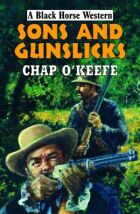
|

|
A lately neglected author who comes to mind is
Frank Gruber (1904-1969). He wrote in quantity for both the western
and detective titles during the golden years of the pulps. He also scripted
at least a couple of Universal's revered Sherlock Holmes movies
starring Basil Rathbone as the great detective and Nigel Bruce as
his Watson. Made on low budgets in Hollywood during World War II,
Terror By Night and Dressed to Kill (aka
Prelude to Murder) are now in the public domain and have
been reissued several times on DVD packs of varying quality. They are
fun nostalgia, often at a modest price. (But a conductor on a
London-Edinburgh express. . .?)
If only a western movie will do, why not hunt out 1955's Rage
at Dawn, another classic widely available on DVD? It's based
on Frank Gruber's fictionalization of the story of the Reno Brothers gang
and stars Randolph Scott, Forrest Tucker and J. Carrol Naish. Scott plays
James Barlow, a detective agency operative sent from Chicago to infiltrate
the gang.
|
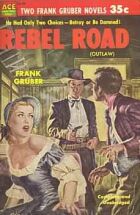
|
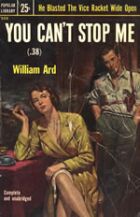
|
Gruber's twentieth century detective creations, featured in crime
novels worth tracking down, were Simon Lash and Eddie Slocum, Johnny
Fletcher and Sam Cragg, and Oliver Quade.
For the large and small screens, Gruber reputedly wrote more than 200 scripts or scenarios, mainly
westerns. He created several television series, notably Tales
of Wells Fargo, The Texan, and Shotgun Slade (1959-61). The last combined his favourite genres: Slade
was a private eye in the Old West.
Another prolific crime and western writer of the same period was William
Ard. He was mentioned not long ago by James Reasoner at his absorbing
blog, Rough Edges. James is a writer with a sure foot in both camps today;
Ard was the private-eye tale-teller with the Timothy Dane and Lou Largo
series who, under the name Jonas Ward, created the long-running Buchanan
westerns.
Ard wrote the first five books featuring Tom Buchanan, one of which was made into a movie in 1958, again
starring Randolph Scott. Buchanan Rides Alone
was filmed tongue-in-cheek by famed western director Budd Boetticher,
based on the novel The Name Is Buchanan.
|
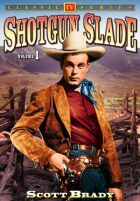
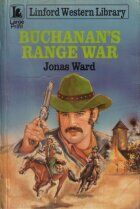
|
|
Ard died during the writing of the sixth Buchanan book,
and it was completed by science-fictioneer Robert Silverberg.
The series was continued by Brian Garfield, another writer now
also renowned for crime fiction, who contributed Buchanan's
Range War before William R. Cox took over with titles including
Buchanan's Stage Line.
Buchanan had a memorable pard in Coco Bean, a prizefighter,
holding the title Black Champion of the World.
|
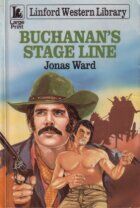
|
 John Hunter
John Hunter
|
In Britain, writers of light fiction made similar crime/western crossovers through the years.
Veteran John Hunter (1891-1961) was a key contributor to the
Amalgamated Press's Sexton Blake Library detective series well into
the 1950s.
As a boy, I developed a taste for Hunter's tightly written, exciting stories which tempted me to sample his
Lannagan novels for the same publishing company's Western Library.
They appeared in identical, inexpensive format -- two slim paperbacks
a month with digest-sized, newsprint pages. The westerns had vigorous
covers by James E. McConnell or Derek C. Eyles.
|
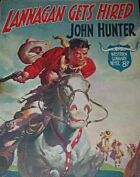
|
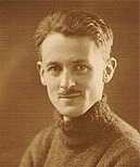 Rex Hardinge
Rex Hardinge
|
The Lannagan novels were accompanied by Western Library's reprints of the likes of Ernest Haycox, Max
Brand and William Macleod Raine. Among other British crime writers
contributing were Rex Hardinge, T.C.H. Jacobs and Sydney J. Bounds.
Rex Hardinge, like Hunter, was a Sexton Blake
author. He was renowned for his stories set in India and Africa which
he knew from first-hand experience. During World War II, Hardinge
served as an officer in Military Intelligence. He was parachuted
into China in 1942, remaining there until 1946 with "a cloak and
dagger outfit".
He wrote his westerns as Rex Quintin and Charles Wrexe. More can
be read about him at www.sextonblake.co.uk, the absorbing site put together by Mark Hodder.
|
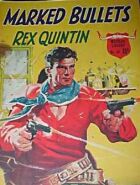
|
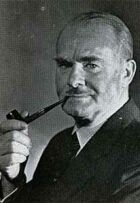 T. C. H. Jacobs
T. C. H. Jacobs
|
Crime writer T. C. H. Jacobs (1899-1976), aka Jacques Pendower, Penn Dower
and Tom Curtis, wrote original Western Library novels about a Texas marshal
called Whip McCord, starting with Texas Stranger. I believe several were later reissued in hardcover versions by John Long Ltd.
From 1960, Jacobs's publisher for crime novels was Robert
Hale Ltd. The Perfect Wife, published by Hale in 1962
under the Pendower name, features Slade McGinty, a private eye with an
office-cum-flat in Brewer Street, Soho. McGinty is commissioned to seek
information about the young, popular and charming Lady Sandra Bondell,
who "sounded more like a saint than a modern young woman. Too damned good
to be true."
|

|
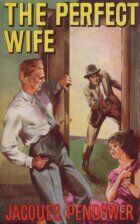
|
Vintage detective novels by Jacobs published in the 1930s (US, Macaulay;
UK, Stanley Paul) are listed by Allen J. Hubin as genre classics.
Jacobs had a keen interest in medical jurisprudence, also writing
true-crime articles and books. And interest in criminal psychology could
be put to use in a western, too, adding depth to plot and characterization:
"Slim, he thought, was not to be trusted with any lethal weapons.
Such concentrated hatred in one so young fascinated Whip. He wondered
if there was anything in heredity. Lefty Masters had been a killer. So,
it seemed, was his son. Or was it merely environment? Slim would have
been reared in the company of outlaws. He must inevitably have absorbed
their anti-social thought and actions."
|
|
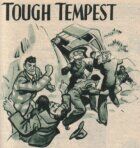
|
In the 1960s, when I was an editor for Micron Publications
and Odhams Books, I asked Jacobs to contribute material and came to
know him through letters and phone calls. Eventually, Jacobs invited
me to lunch at the Wig and Pen Club in Fleet Street. Despite big differences
in age and background, it consolidated a rapport. Born in Devon and
living in Kent, Jacobs was a soldierly, no-nonsense gentleman who called
a spade a spade in a voice that was gentle and gruff at the same time.
Sadly, commercial fiction today supports very few craftsmen of his kind.
His experience was wide and long -- the army,
the civil service, radio, film, Rotary, the Crime Writers' Association.
. . . Jacobs's novel Traitor Spy was filmed in 1939-40,
starring Bruce Cabot and released in the US as The Torso
Murder Mystery. For D.C. Thomson, the periodical publishers
based in Dundee, Jacobs was the author who wrote possibly the largest
number of detective stories featuring Dixon Hawke, the company's
rival to Sexton Blake. Jacobs produced most of the Hawke serials that
appeared in the weekly Adventure in the 1930s as well
as stories for the annual Dixon Hawke Casebook.
In 1949, for the Amalgamated Press, Jacobs wrote a western text series for Knockout paper, Buffalo
Bill -- Frontiersman. In December a year later, it was
back to detectives for the same firm's Sun, with a
series about Tough Tempest -- Crime Buster -- launched
in that publication in the same issue as Barry (Joan Whitford) Ford's
Law of Wild Bill Hickok series.
I suspect Jacobs's work may not be valued completely in his
home country. Today, perhaps the finest store of his literary papers
and manuscripts is kept in the Special Collections Library of Pennsylvania
State University.
|

|
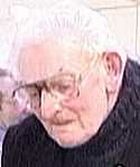 Sydney J. Bounds
Sydney J. Bounds
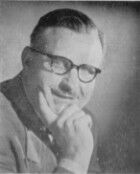 John Creasey
John Creasey
|
Another prolific "old hand" I worked with,
Syd Bounds, wrote for Western Library as James Marshal, and while
his speciality was science fiction, he could turn his hand
to just about anything, including crime stories. In recent years,
Syd wrote the Savage series of BHWs. A Man Called Savage
is to be reissued by Ulverscroft in large-print this summer, joining
Savage's Feud and making at least a couple of his westerns
more readily available to US readers.
Also writing both crime and western fiction
in the '50s was Vic J. Hanson. His crime yarns were gangster fiction
of the Hank Janson kind, but he later turned to Sexton Blake detective
stories. And then came many, many Hale westerns under
his own name and Jay Hill Potter.
Hanson, Bounds, Jacobs and Hardinge all accepted
invitations to write for me in the '60s when I was editing
Western Adventure Library, Cowboy Adventure Library and
-- in the crime line -- Edgar Wallace Mystery Magazine.
John Creasey (1908-1973) --
of Toff and Gideon fame, prolific author of hundreds of crime
novels -- wrote about 30 westerns in the 1930s and '40s as
William K. Reilly, Tex Riley and Ken Ranger. Once, he made the mistake
of mixing up coyotes with buzzards or vultures. Because he was British,
he was never forgiven for the "flying coyotes". Some US editors
and literary agents didn't just laugh. They used the famous gaffe for
years as grounds to reject automatically all westerns written by Britons
-- notwithstanding Creasey wrote his, for him, small bunch in probable
haste and difficult circumstances without the benefit of the research
and reference books available today, let alone the Internet.
|
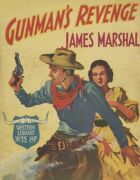
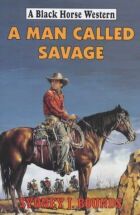
|
|
Meanwhile, "indigenous" writers --
an agent's adjective, not mine -- were allowed to survive unscathed
sins of poor research similar to Creasey's. For example, as late
as 1990, a respected western/crime writer could set his novel in
1901, write of a character anachronistically "zipping up his pants",
yet continue to receive the critics' adoration in august trade journals
such as Publishers Weekly and Booklist,
and later have the work in question anthologized as one of the great
stories of the American West. (Which it is, by the way.)
I hold no brief for John Creasey, beyond
objection to the mean-spirited exclusion of anyone, but I did have
a strong appreciation of his crime novels, which gave me countless
hours of enjoyment in teen years and earlier. Copies of his westerns,
as will be seen, I didn't come across in my youth. It was only late last
year that I had the lucky chance to buy one. They are in the rare books
category. Thus they change hands at prices way beyond the means of those
who primarily read westerns rather than invest in them as collectibles
or trophies from eBay hunts.
The Creasey western I read recently was a
Western Library reprint of Riders of Dry Gulch,
which avid Creasey bibliographer Richard Robinson records was
originally published by Herbert Jenkins Ltd in 1943. Confirming this,
I have in my files the handwritten note below which Mr Creasey
sent me in 1958. The author lists the publishers for one of his
mystery personas and his three western identities . . . and regrets
that the westerns are, even then, out of print. None of them ever did
reappear in the Jay Books paperbacks he mentions.
|
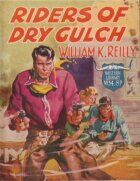
|
|
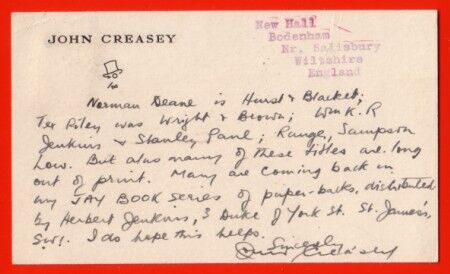
|
|
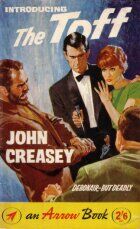
|
The Dry Gulch novel's main drawback
is adherence to a common practice of its age -- trying to convey
supposedly western dialect through bizarre spelling. Clarity is
sacrificed on occasion to no good purpose in the "jumpin' jack-rabbits"
dialogue. Some might also find a lack of authenticity in the Texas setting.
Particularly, the chapters set in El Paso would require, for today's
knowledgeable reader, greater research attention. But bursts of action
are frequent and, despite a little meandering in the storyline along
the way, a villain is unmasked in the last chapter. Mystery elements
feature as prominently as in the Creasey crime novels of the period
-- the Peter Mantons, Norman Deanes, Anthony Mortons, Gordon Ashes
and so on.
A good man is framed and persecuted; an eccentric
runs loose. You are left in no doubt about what kind of story
you are reading when lawyer Petrie tells cowboy hero Boyd Warren
in an early chapter, "I'm a long way happy 'bout Long Paul. Is he more
than he pretends? Is his queerness acted? Answer that, and maybe yuh'll
answer a lot more. Ther's plenty that want answerin' in Dry Gulch.
If Olsen was wrongly convicted, as I think, ther's a man at large,
more than one man, I know, but one who organised these killings and
lootings. Since Olsen left, there has been none of them, but I live in
constant dread that they will break out again."
Maybe for the people who read and wrote in
wartime Britain, a mystery novel set in a faraway Old West
provided a more complete escape than a novel placed in a society
and against a background where familiar detail couldn't help but
remind them, along with the nightly air raids, that the way of life
they cherished was under appalling threat. Quaint (wistful?) mention
is made in Riders of Dry Gulch of steak "juicy-looking,
sizzling in the heat", bacon and eggs, chickens on spits and a smell
of frying steak.
Before World War II, in 1938, Creasey had
dedicated the novel Introducing the Toff, published
in hardcover by John Long Ltd, to the Amalgamated Press man who
later edited both the Sexton Blake and Western Libraries. The dedication ran,
"To L. E. Pratt, who first put the Toff into print."
|
|
|
Richard Robinson told me a few years ago, "John's westerns
are like the Holy Grail -- and some of the harder books to find. At a recent
get-together [of a group of Creasey enthusiasts] we had just over a half
of them in various editions. Several were published in magazine form in the
US and are more common."
Though Creasey's reputation rests on his hundreds
of crime novels, I think he maintained a pride in his western
writing after it became unobtainable. He was an assiduous publicist
and in the late '50s issued a greetings-style card to his reader
correspondents with the title "Creasey books are on top of the world
. . . and here are some of the reasons why". In it is the sentence:
"He is the only English member of Western Writers of America." Which
should have been qualification enough to clip the wings of any patriotic,
wild-west high-flyer objecting to sharing his air space with coyotes!
|

|
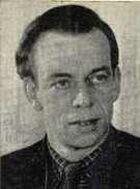 Jack Trevor Story
Jack Trevor Story
|
Among the later Sexton Blake writers who
also wrote, or had previously written, westerns was the much
under-rated Jack Trevor Story, author of The Trouble With
Harry, filmed by Alfred Hitchcock, and Live Now,
Pay Later. Story's "rather good westerns", as he described
them, were mostly about a character called Pinetop Jones and were
published in the '50s, usually in hardcover for the lending library
trade, by Hamilton (Stafford), originators of the Panther Books
paperbacks. When I was in London copy-editing Sexton Blake novels
for the Amalgamated Press in the early '60s, I was completely unaware
that Story had also been western authors Bret Harding and Alex Atwell.
On the back cover of a Panther Books hardcover,
Harding's author bio says, "He has always been interested in
the genesis of the western novel, especially those in which character,
humour and genuine suspense take precedence over the stereotyped
horse opera plot." Mystery, romance and intellectual eccentricity
are also mentioned. Anyone who met Story, or has read his work or
about him, knows something of the last! To sample an opening chapter
from a quirky Jack Trevor Story western go to http://www.jacktrevorstory.com/pinetop_jones.htm
. The entire website is an excellent tribute.
|

|
 Terry Harknett
Terry Harknett
|
By the end of the Swinging Sixties,
few British crime writers were left dabbling in westerns, or
admitting they once had. Then came the '70s and the influence of the
Italian movie makers with their violently dramatic, spaghetti westerns.
A younger generation of British writers took on board the lessons. Terry
Harknett, a self-confessed "frustrated mystery writer" with "no particular
penchant" for westerns, slipped into the scene almost by accident.
"For fifteen long years I wrote mystery novels
[for Robert Hale Ltd] that were published twice yearly -- and
sank without trace at the same rate," he told the US magazine The
Writer.
Luck took a hand, he said, when he was hired to write a "book of the
movie" and it happened to be a western. "I had not seen it and I had
never read a western novel."
But the rest is history. He did a few more; it
was realized nobody was writing books like the tough spaghetti
movies; he assumed the pen-name George G. Gilman, and the famous
Edge paperbacks came into being.
Soon, every paperback publisher in London had
an Edge-series clone. The stories were written almost exclusively
by a coterie of writers who followed, perhaps unknowingly, in
the tracks of an existing tradition of writers "who hadn't been
further west than Paddington Station". They won themselves a higher
profile than the forgotten British western writers of earlier decades
and became known as the Piccadilly Cowboys. Among them were John
B. Harvey and Mike Linaker.
John Harvey's books had the trademark of the
PCs which was gritty realism, the more sordid it could be made the better:
"Wes Hart woke sticky with sweat that lay on his body like cloying vomit,
turning cold." Harvey did the opposite to Terry Harknett -- he later
headed completely away from his fascinatingly ugly westerns, about
Hart the Regulator, to write bestselling crime novels about Detective
Inspector Charlie Resnick.
Mike, as Neil Hunter, Richard Wyler and John C. Danner, still rides
the range for Black Horse Westerns and the large-print Linford Western
Library, while his bill-paying work is blockbuster adventure thrillers
for Gold Eagle's series based on Mack Bolan lore.
|

|
 Mike Stotter
Mike Stotter
|
Associated at an early stage with producing a
fanzine for Harknett's GGG fans, another Mike -- Mike Stotter
-- graduated to writing westerns of his own. In 1997, Ed Gorman
and Martin H. Greenberg chose an extract from Mike's first BHW,
McKinney's Revenge, for inclusion in The
Fatal Frontier. This was a 420-page anthology in which
Gorman and Greenberg demonstrated the direct links between crime
fiction and western fiction, proving the contention with a fine collection
of stories from Elmore Leonard, John Jakes, Brian Garfield, Marcia
Muller, James Reasoner and other top-selling crime and mystery
authors. Today, Mike continues with occasional western projects,
but he is also highly respected as the editor of the crime fiction website
Shots ( www.shotsmag.co.uk).
|
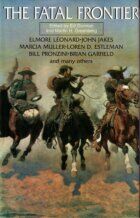
|
|
To compile a complete history of the parallels
between hardboiled detective stories and westerns would be
beyond my capabilities and take space unavailable here. But I will
add that a lifetime's enjoyment of tightly plotted crime thrillers ensures
I'd be less than satisfied with writing a Chap O'Keefe western which
didn't contain mystery and suspense. For stories about the series character
Joshua Dillard, an ex-Pinkerton detective, the elements are routinely
accommodated. The Gunman and the Actress and The
Lawman and the Songbird attempt a pattern set by genre classics.
So, too, do Shootout at Hellyer's Creek, The Sandhills
Shootings, Ride the Wild Country and this month's
Sons and Gunslicks. Every time, the intention has been to spring
plot surprises and solve puzzles in the closing pages of action-packed
yarns.
My other series character, Misfit Lil, similarly
encounters situations more common to crime stories. In one forthcoming
title, Misfit Lil Hides Out, she is framed for murder.
As always, resourceful Lil makes some ingenious plays and produces
the necessary answers to a mystery with a flourish at the end.
|
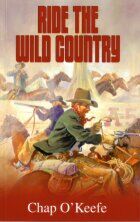
|
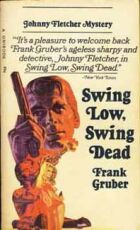
|
To wrap up, let's return to Frank Gruber
with whom we started. The aim here -- in case detractors are itching
to level the charge -- has not been to paint a picture of a cosy club of forgotten
old fogies. Way back in January 1941, Gruber made the following
comments, in which you could substitute "western" for "mystery" all
the way through:
"The manager of a large book store gave me
an advance copy of a mystery novel by a new author and asked
me for my honest opinion of the story.
"It started off swell. The detective
was a colourful character. The writing had a vitality you
seldom find, the dialogue was crisp and the story moved.
It lacked only two things, but those two things meant all the
difference between an outstanding mystery and 'just another mystery
novel.'
"The story lacked a theme and it lacked invention. All right, nine
out of ten mystery novels lack those two very same things. That’s
why they sell their 2000 to 3000 copies and are forgotten. A dozen
or so mysteries stand out every year from five hundred that are
published. In practically every case these outstanding mysteries
have both theme and invention.
"In a previous article in the Writer’s Digest I stated my
opinion that a colourful theme was vital in a bestselling mystery
novel. I still hold that to be true, but now I add that without
invention the theme falls flat. . . .
"All detective stories have the same basic
plot. A murder is committed, perhaps two or three; questions
are asked and answered and your detective makes certain deductions
and eventually pins the guilt upon the culprit.
"Every detective story writer has to work
from his skeleton plot. The dressing he gives it is what makes
his story different from other detective stories. But too often
this dressing is commonplace. The jaded detective story reader
has read essentially the same thing a hundred times. Murder
in itself is no longer startling or unusual.
"That is why the smart detective story
writer gives his story invention.
"In my own case, I try to have a minimum
of six or seven inventions in a novel and I try to space them
out so there’ll be one every two or three chapters. . . .
That is exactly why this story falls flat on its appendix. It has
nothing different in it, nothing unusual. It lacks both theme and
invention."
Some advice is timeless. I hope, as either readers or writers, we can count on theme
and invention being among the ingredients in many of today's Black Horse
Westerns.
-- Keith Chapman, aka Chap O'Keefe, whose
latest BHW is
Sons and Gunslicks.
|
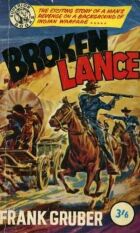
|
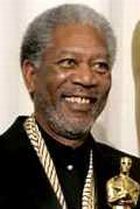 Big fan of westerns. Big fan of westerns.
|
An
assortment of the
right tracks
HOOFPRINTS
Morgan Freeman co-starred with Clint Eastwood in the
actor-director's acclaimed western Unforgiven, but he's determined
at age 69 not to retire until he has done another. He told Big Picture News
Inc, "I haven't even scratched the surface. There is great stuff that hasn't
been touched by me ... I'm a big fan of westerns, and I haven't
done my ultimate one. There are many stories to tell." Freeman, an Oscar
winner, has played widely diverse roles, including several
detectives, a convict and a poor black chauffeur, but he has expressed
in the past an eagerness to complete the list by playing a deputy marshal
from the 1870s. "No one knows about the law officers who populated the
West -- the deputy sheriffs, deputy marshals and people of that ilk who
were in Texas, Oklahoma and Arkansas. This guy's name was Bass Reeves
and he was a true character. It has been in the pipeline for years and
it's something I really want to do, but we have a problem getting the
script together. That's the hardest part of any movie." Come in, Adam
Wright. . . ? In 2001, Adam fictionalized Reeves's story for a BHW
novel.

|
|
|
Thought mixing horror with westerns was a new development?
Think again! Los Angeles Times "resident expert" Kenneth Turan
listed among "notable DVD offerings in film" Creepy Cowboys:
Four Weird Westerns. He said The Rawhide Terror,
Tombstone Canyon, Wild Horse Phantom and Vanishing
Riders were examples from the 1930s and '40s of westerns with
pronounced horror/mystery elements. Stars included Tom Mix,
Ken Maynard, Buster Crabbe and Bill Cody. Another
reviewer said. "So old they creak, but man oh man, are they fun." Not
bizarre enough? Turan also recommended Westerns With a
Twist, a trio of full-colour westerns -- Apaches,
Chingachgook — The Great Snake and The Sons of
the Great Bear. These movies were made in East Germany during
the Cold War years -- "Red Westerns" -- and star a Serbian actor, Gojko
Mitic, as a heroic Native American battling perfidious white settlers.
|
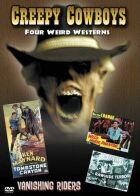 Screams of laughter.
Screams of laughter.
|
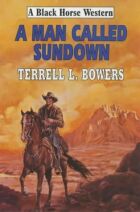 Roped in.
Roped in.
|
Avalon Books
is a US publisher of wholesome adult fiction. "Substitute euphemisms in
all instances where profanity, including 'damn' and 'hell', might be used,"
its rules for writers say. On the back of a title issued in the mid 1980s, the firm listed 38 of
its westerns. They included no less
than 15 by Terrell L. Bowers. Today the veteran author is a valued
contributor to the BHW series who made his first entries in the line's debut
year, 1986. He told Avalon he sometimes thought he was born with boots
and spurs. His father was his inspiration. He provided Terrell with his
own horse and cows to ride and rope. On small acre lots or fair-sized farms,
he always had the fixings for cowboying on hand. Terrell also shared his
father's taste for movies starring Bob Steele, Johnny Mack Brown, Roy
Rogers and John Wayne. Western blood was in his veins, and he
loved to create a new story, new characters -- then let his imagination
run wild. "Fortunately," he once wrote, "I have a beautiful, loving wife
and two angelic girls, who understand and accept my endless hours at a typewriter.
My principal desire is that somewhere there are western lovers who find
my stories entertaining." His latest BHW is The Trail to Yuma.

|
|
|
Another case of myth versus reality. . . . The stereotype western hero
is at least six feet, sometimes taller, and is sometimes said to have been
a former cavalry officer. But we are told the US regular cavalry had a
maximum height limit of 5 feet 10 inches. Some cavalry officers who were
state-raised militia, or men who raised their own regiments during the
Civil War, were big men, but regular cavalrymen were supposed
to be 5 feet 10 or less. The late John Wayne often portrayed a cavalry
officer in movies, yet at 6 feet 5 inches he would have been much too big
for the regular cavalry. The average man of the era would have stood about
5 feet 8 inches if Civil War records are taken to be a guide. And though
some Indians were tall, most were smaller than white men.
|
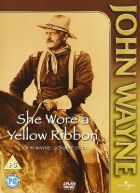 Role sized up.
Role sized up.
|
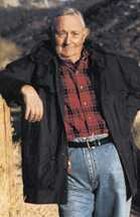 Hillerman: clouds
Hillerman: clouds
part.
|
In a Western Writers of America press release, award-winning
mystery writer Tony Hillerman said, "Western writing, to me is
when you're flying from the east and clouds block the view. You can't
see a thing. Then, you're over west Texas. The clouds part and what
do you see? Endless miles of sunshine and wide open spaces." WWA said
that over the past few decades, western literature had slid into an
abyss of reader apathy, but they were now facing a promising future.
Purchases of westerns in the United States increased 9 per cent in 2005
and 10 per cent in 2006. Publishers representative Larry Yoder said
today's westerns weren't what your grandfather read or "some TV show with
a predictable plot". WWA president Cotton Smith added stirringly,
"Western literature is of the spirit, our spirit, the spirit of America.
Western literature is the motivation of people to succeed in lands greater
than themselves. The Western is full of souls filled with concern, fear,
joy and desire. In a phrase, it is the literature of America's soul." Wow!
Remember that next time someone dismisses the book you're reading or writing
as "just another shoot-'em-up".

|
|
|
Multi Spur Award winner Richard S. Wheeler, graciously given space
at Ed Gorman's new, improved blog, raised doubts about the sales
health of the western in response to the WWA release. After some debate,
he said, "The death throes of a major American literary genre have occurred
beneath the periscopes of the journalists of literature and the book world.
These people don't care about western fiction, and know their readers
wouldn't care either, which is why the genre is all but gone." Wheeler
queried sales figures that failed to "distinguish between books published
commercially and vanity books done by print-on-demand publishers". Two
of Wheeler's fine westerns have appeared as BHWs: Sam Hook
(December 1987) and Stop (April 1990). Ed Gorman westerns,
too, have been issued in BHW, British-market editions: Gundown
(February 1997) and Wolf Moon (July 1998). For western readers
whose foremost requirement is a brisk and lively read, the blog debate furnished
extra reasons for western readers to support the Hale (and hopefully hearty)
series with purchases and library borrowings of the newest titles.

|
 Wheeler: clouds gather.
Wheeler: clouds gather.
|
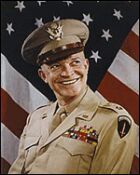 Ike's endorsement.
Ike's endorsement.
|
Never underestimate western fans. Paddy Gallagher (aka Greg Mitchell)
reminded Hoofprints that General, later US President Dwight D. Eisenhower
was an avid follower of westerns and his favourite movie was The Big
Country. "To broaden the scope of the books, the publishers should
be aiming higher and breaking new ground," Paddy said. "The most positive
feedback I got from my first BHW, Outlaw's Vengeance, came
from a well educated bloke I know who had never read a western in his life.
He read the book only because he knew me -- but he enjoyed the western atmosphere
so much, he was going to read more by other authors." Paddy, who lives near
Canberra, Australia, is currently working on completing his latest western
for a New York publisher, who responded to material held for a considerable
time. "It seemed to have disappeared off the face of the earth. . . . Then,
out of the blue, a letter arrived saying they liked what I had sent over
and would be interested in seeing the rest."

|
|
|
BHW writer Paul Wheelahan is known in his native Australia as a
comic-strip artist -- creator of The Panther (1957-63) --
and as the author of countless Cleveland western paperbacks under pen-names
including Brett McKinley, Emerson Dodge and Ben Jefferson.
His first BHW, Branded!, appeared under his own name in September
2000 and was followed by several more. Then, like prolific compatriot
Keith Hetherington who'd already joined the Hale camp, Paul adopted a
string of bylines: Dempsey Clay, Matt James, Ryan Bodie, Ben Nicholas
and Chad Hammer. Fellow author David Whitehead says, "One of the tricks Paul employed back
in his Cleveland days was to write the last of ten chapters first. Then,
if he found that the story was taking longer than anticipated to tell, he
could cut and compress it somewhere around the middle, thus avoiding the
usual problem of having a rushed ending." Paul's latest BHWs are Just
Call Me Clint by Chad Hammer and Gun Lords of Texas
by Matt James.
|
 Last chapter first.
Last chapter first.
|
 Reality for SF writer.
Reality for SF writer.
|
Western readers and writers were reminded that not all genres are fortunate enough to have a BHW series. Leo Stableford commented to blogger Grumpy Old Bookman, who'd written about the difficulties facing the genre writer, "This is possibly the best post I have ever read in any blog
ever on the topic . . . My father is a mid-list SF writer and academic and only started to have anything
like a career when the number of novels he'd written approached the late 40s
or early 50s (I really don't remember). Unfortunately, in today's world he didn't sell as was required, and now finds
securing a publisher impossible in the mainstream and challenging elsewhere.
He'd never even have got a foot in the door had he been born 30 years after
he was."
|
|
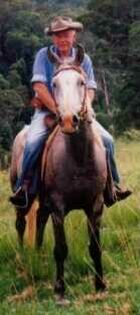
|
Greg Mitchell dispels misconceptions
ENDING WITH A BANG
. . . as Joshua
left the house's enclosure, the fleeing woman turned. In her hand, as if by
magic, there appeared a revolver.
It was a big, hefty piece of armament, with a barrel about nine inches
long. Joshua's expert eye placed it, possibly, as an old Walker Colt which
in total length would measure more than fifteen inches. Not exactly a lady's
pistol, Joshua thought, and forged on relentlessly.
"Stop!" he ordered. "That ancient piece of hardware will be useless
to you."
Sons
and Gunslicks
Chap O'Keefe
THE Walker Colt .44 revolver is a great favourite with western writers and
was the preferred weapon of many fictional gunslingers. But in real life,
it owed any popularity it gained to the fact that it had no competition.
Its predecessor, the Paterson Colt, was patented about 1836 and was the
first practical revolver. The Paterson revolutionized the handgun world but
it had its limitations. It was not a particularly robust arm with the choice
of five shots in calibres .28, .31,.34 and .36. The cap-and-ball, percussion
revolver was slow to load with loose powder, balls and percussion caps. If
the chambers were not sealed with grease or beeswax, the balls could be jolted
loose when carried muzzle-down on a horse, though the advantage of having
multiple shots outweighed the disadvantages.
The public at large did not receive Samuel Colt's revolving handgun with
enthusiasm. Colt ran into financial problems and he had to close his factory
at Paterson, New Jersey.
Among those who were quick to appreciate revolvers could be counted the
Texas Rangers. They used them against hostile Comanche warriors and Mexicans
to great effect. But they saw that improvements were needed. Consequently,
Captain Sam Walker approached the Colt company with ideas for an improved
revolver. The new weapon, produced for the rangers in 1847 and designated
the Walker Colt, was a radical departure from the Paterson but a much more
practical weapon.
The cylinder capacity was increased to six chambers, each capable of accommodating
more than 40 grains of powder and a .44 bullet. A conventional trigger guard
replaced the Paterson's folding trigger and a rammer attached under the barrel
ensured that the bullets were firmly seated in the chambers. The weapon was
heavy, slightly more than four and a half pounds in weight but that helped
to reduce the recoil from its powerful loads.
Colt arranged with the Whitney Armoury at Whitneyville, Connecticut, to manufacture
the new revolver. The factory produced 1,100 Walkers and they were the most
powerful handguns of the day. The profit Colt made was enough to set him
up in new headquarters at Hartford.
Glowing contemporary reports claim that the Walker was more effective than
the "common rifle" at 100 yards and more accurate than the smoothbore musket
at 200 yards. The claims should not be taken at face value. Much depends upon
the definition of the "common rifle". The same weight of bullet and the same
powder charge would generate much more speed and energy in the longer rifle
barrel, as the famous Winchester '73 later demonstrated. The Walker fired
a rifle-sized charge but in the shorter barrel could not match rifle ballistics
for similar loadings. It was more accurate than the musket at 200 yards because
its barrel was rifled. The smoothbore musket had little accuracy beyond 90
yards. Uneven gas escape from around the ball sent the bullet astray. A musket
ball might travel a fair distance if the right elevation was given to the
weapon but long-range accuracy was out of the question.
Many early Colts were sighted to hit the point of aim at 60 yards so inside
that range they shot a little higher. Given the right elevation of the barrel
their extreme range was about 1,400 yards but both power and accuracy would
be lacking by then.
The Walker's large powder capacity was also its downfall. Some claim that
as much as 50 grains of powder could be crammed into the chamber although
the recommended charge was 40 grains. Of the 1,100 Walkers produced, approximately
300 were said to have blown up as a result of cylinder failure. It had been
the most powerful revolver of its day but the day was a short one.
Colt rapidly improved the Walker to produce the Colt Dragoon which was lighter,
better balanced, and with superior craftsmanship and materials. It could still
fire a 40 grain powder charge. After three models of Dragoon, the last big-bore
Colt percussion revolver was the streamlined 1860 .Colt Army. It still
fired a .44 bullet but the powder charge was reduced to 28 grains. This gun
was noted for its easy pointing and accuracy. Because of patent problems,
Colt could not start producing metal-cartridge revolvers loading through
the rear of the cylinder until 1871.
Percussion revolvers quickly went out of favour. They were unreliable and
difficult to load when compared with the newer types.
Was the Walker ever a gunfighters' gun? It was only when nothing better
was available. The length and weight made it an ungainly weapon unsuited to
quick draws and the arm lacked the natural pointing ability that was a feature
of later Colt revolvers. It was obsolete before the American Civil War.
Carrying ammunition for percussion revolvers was always a problem. At first
the shooter had to carry a small flask designed to deliver a measured charge
of powder, loose bullets and a supply of percussion caps. Some also carried
a small quantity of grease to seal the mouths of the chambers to keep the
powder dry and to avoid chain fires. Later, combustible paper cartridges containing
measured powder charges were attached to the bullets but these were prone
to damage that made them difficult to load. The cavalry carried these cartridges
in wool-lined pouches to prevent them being damaged. But separate percussion
caps still had to be added before the weapon could be fired.
By 1870 metallic cartridges had proved their worth and percussion weapons
were being phased out. Revolvers like the Walker took too long to load and
had a high rate of misfires. They also had the disconcerting habit of "chain
firing" when all chambers discharged at once. This fault also sounded the
death knell of the Colt revolving rifle. A man holding a revolving rifle in
the conventional manner could lose all or part of his left hand if the weapon
chain fired. The only safe way to hold a Colt revolving rifle was for the
left hand to hold the front of the trigger guard. They were considered so
dangerous that they were withdrawn from Union troops during the Civil War.
In 1873, the Winchester company brought out the improved, centrefire version
of their popular 1866 repeating rifle. The cartridge was designated the .44/40.
and fired .44 bullets propelled by 40 grains of powder. This was a similar
load to that fired by the Walker Colt. The Colt company in the same year
introduced the famous .45 calibre, Frontier Colt. Then in 1876, Colt started
chambering Frontier Colts for the .44/40 cartridge so a man could use the
same ammunition in both rifle and revolver. In a revolver, the .44/40 had
marginally less hitting power than the Colt .45.
A gunfighter who continued using percussion arms after 1873 was certainly
flirting with the hurting. Although Wild Bill Hickok had a pair of .36 Navy
Colts, he was thought to have possessed metallic cartridge weapons, too. The
James Brothers, the Earps, Bill Cody, Bat Masterton and Billy the Kid Pat
Garrett and a host of outlaws all used metal-cartridge revolvers. There would
be little demand for a weapon as unreliable and outdated as the Walker Colt.
The Walker was an important development in revolver design but did not deserve
the legendary status that some writers later gave it. Lightning draws and
trick shots were out of the question with these weapons but if they hit a
man, he stayed hit.
-- Paddy Gallagher, aka BHW
writer Greg Mitchell
|
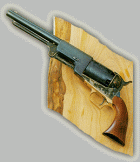
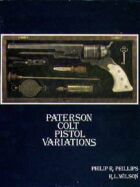
 Paterson factory
Paterson factory
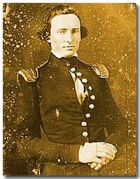 Sam Walker
Sam Walker
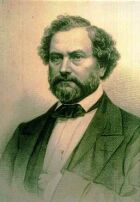 Sam Colt
Sam Colt
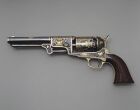 Dragoon
Dragoon
 Army
Army
 Frontier
Frontier
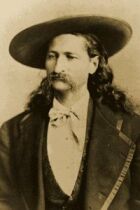 Wild Bill Hickok
Wild Bill Hickok
|
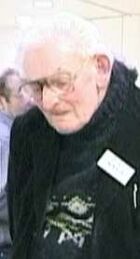
|
The Extra pays tribute to Sydney J. Bounds
FAREWELL TO A SMALL GIANT
Jess Harper sat
alone on a pine bench outside his rough-hewn log cabin, waiting. Behind
him, the late afternoon sun sank beyond the rim of the canyon, and the
cabin gave him shade. The air was stifling hot, dry, and the yard inch-thick
with dust.
Short and broad, Harper had the solid build of a grizzly, his hair
touched early with iron-grey. His rugged, almost homely, face showed lines
of stubbornness.
Lynching at Noon City
Sydney J. Bounds
FOR discerning readers of BHWs, 2006 ended sadly with news of the death,
on November 24, of veteran author Sydney J. Bounds, aged 86.
I knew Syd in London in the 1960s and had huge respect for him as
one of the most versatile workers in the genre-fiction business -- SF,
detective, western, horror, plus scripts for war libraries and even nursery
comics. Quietly spoken, small in stature, non-assertive, he was the true
professional. Editorially, I had the pleasure of handling his work at
Fleetway House, for the Sexton Blake Library detective series, at Micron
Publications, for the Edgar Wallace Mystery Magazine, and at Odhams Books,
for various boys' adventure annuals.
Editors and publishers continued to hold him in esteem. My sentiments echo
those of John Hale, chairman and managing director of Robert Hale Ltd.
"I am sure he was the oldest author on the BHW
list. I cannot remember ever having had personal contact with him direct,
as in recent years all his work came to us via an agent. However, my recollection
is entirely of an unassuming and highly professional author who could turn
his hand to all sorts of fiction writing."
|
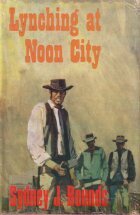
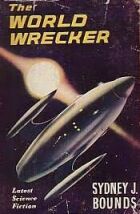
|
|
Even as the office junior at Fleetway, I recognized Syd was much
under-rated. His Sexton Blake novels were published as by Peter Saxon,
George Sydney and Desmond Reid -- all "house" pen-names -- but my memory
is that the re-write work on them was barely necessary. When a Blake novel
was later chosen to be serialized for the first time in a widely circulated
weekly paper, Tit-Bits, it came as no surprise to me that
it was one of Syd's. I've heard, though, that the unassuming Syd wasn't
told and found out only much later.
Sydney James Bounds was born on November 4, 1920 in Brighton, a seaside
resort fifty miles south of London. He worked as an electrical fitter before
moving to Kingston-on-Thames, where he studied electrical engineering at
a technical college. During World War II, he was an electrician and instrument
repairer for Royal Air Force ground crew. At the same time, he began writing
science fiction and fantasy.
Steve Holland, at his aptly named blog, Bear Alley, records that
Syd sold his first story in 1943 and was one of the more prolific authors
of the "mushroom jungle" post-war era of cheap UK paperback publishing.
Steve says, "Although he wrote over 40 novels, Syd’s metier was always the
short story of which he wrote hundreds, many published anonymously in children’s
papers and annuals. Anyone who has tried to make a living from selling
fiction will know the difficulties of changing characters and plots every
2,000 words, yet Syd managed to make a living doing just that for many years.
Although best known for his science fiction, his talent for turning a situation
on its head in one chilling line made him one of the champions of small
press horror magazines of the 1980s and 1990s."
|
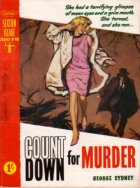
|
|
Among Syd's earlier work, was a string of western novels in the 1950s
for the Amalgamated Press's Western Library as James Marshal. In the 1960s,
he wrote more westerns under his own name for Robert Hale Ltd. These were of the same length
as, and appeared in a similar format to, the later Black Horse Westerns.
Titles I know of were The Yaqui Trail, Gun Brothers and
Lynching at Noon City.
In the spring of 2000, Syd began writing westerns for Hale again after
literary agent Phil Harbottle sold many of his old paperback westerns to
the firm for reissue in BHW hardcover.
The reissues came out under a baffling
variety of pen-names: Howard Baron, Alexander Black, Roger Carne, Richard
Daniels, Sam Foster, Jack Greener, David Guest, Paul Hammond, David Somers,
Wes Sanders, Will Sutton, Neil Vaughan and Cliff Wallace. The new books appeared under
the remarkable octogenarian's own byline.
One book was quickly picked for publishing in the Linford Western
Library large-print series, making it more readily available everywhere,
including the US.
|
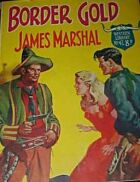
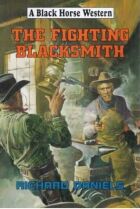
|
|
Savage's Feud was a slam-bang episode in the life of
Syd's series hero, Savage. The feud involved two families, the Howards
and the Flints, and had its origins in the Civil War. At stake was a small
fortune built on a stolen Army pay chest. Also quickly on the line were
various lives, including Savage's.
Though not the first book in the Savage series, Syd's well-honed
storytelling skills made it possible for the reader to piece together
quickly, from allusions in the opening pages and later, that Savage was
a young delinquent from the New York waterfront working as a Pinkerton agent
in the South-west. He was referred to frequently as "small". But his appearance,
of course, deceived -- an attribute he shared with many of the Max Brand
heroes of olden times. Savage was as ferocious as his name. "A strong name,"
said the Indian Little Owl.
At one stage, after a bloody knife-duel to the death, another character
stared at Savage and asked, "Do the Pinkertons have any idea what kind
of animal they've hired?" Savage replied, "Mr Allan [Pinkerton] picked
me himself."
After decades at the action-fiction coalface, Syd's style was as
terse and uncomplicated as ever in this yarn: "He walked up rising ground
to where the house sat on the crest. Lights in the windows were like eyes
watching him. The sky darkened and horses in the corral turned their heads
to stare as he passed by. No doubt there were men behind watching too."
And Syd still had the happy knack of sketching a gallery of colourful
characters, even minor ones, with a few well-chosen words. Thus of a town
marshal: "Even if he did have a wave in his hair and his guns had pearl
handles, they still had real bullets in them." And "The storekeeper gave
a weak smile. He was called the Pope because he wore a stiff collar and
refused to open his shop on Sundays."
The arch-villain was a greedy and self-seeking town boss, as well
as a fanatical ex-Confederate. Wheelchair-bound, he charged at the finale
with a wild Rebel yell and a cavalry sword of good Southern steel extended
before him. "This time, Savage, you're a dead man!"
Another Savage title, A Man Called Savage -- the first --
will be reissued in a Linford large-print edition this (northern) summer.
The latest (last?) BHW is scheduled for May and is also a Savage story
-- Savage Rides West.
Unmarried, Syd lived at the same address, 27 Borough Road, Kingston-on-Thames,
for more than forty years. Like Steve Holland, I can still remember it
from the '60s on editorial correspondence and the cover sheets to his neatly
typed, always tidy manuscripts. Last May, however, he moved to Telford,
Shropshire. Diagnosed with terminal cancer, he was admitted to a hospice and died just a few weeks after his 86th birthday.
-- Keith Chapman
|
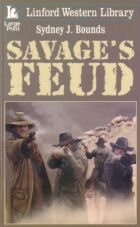

|

|
Literary researcher STEVE HOLLAND holds a special regard
for Sydney J. Bounds. He explains why in this personal Appreciation:
What can I say about Syd? He was a real gentleman and one of the first
authors I ever contacted, way back in 1979 when I was still at school. I
had to do a project for one of our classes, a kind of General Studies class,
where we could choose any subject at all. I chose British SF magazines,
because I'd then recently become interested in them.
Through people like Phil Harbottle and Mike Ashley, I was able to contact
some of the folks involved in the SF mags of the 1940s, one of whom was
Syd. Later, when I had the crazy notion of putting together a small mag,
Syd contributed a story. My project came to nothing, but I did subsequently
publish one of Syd's stories in a souvenir booklet produced for the first
Paperback & Pulp Bookfair.
Syd attended all the book fairs and turned out to be as friendly and generous
in person as he was in correspondence. We talked about his long career as
a writer, usually about his SF stories, or the stories that had appeared
in annuals, or maybe the comic strips he'd penned -- whatever I happened
to be researching at the time.
Because Syd was a professional, he could
turn his hand to any genre and succeed. I don't mean to imply that he was
a hack who would simply go where the money was being offered, although all
professionals are forced to do that to a degree. He didn't have the hack
mentality. He wouldn't just rehash some old idea dressed up as something
new. . .he always tried to bring something new to everything he wrote that
could often turn a stock situation on its head. He was also a very good
writer of twist-in-the-tail short stories. Unlike the true "hack writer",
Syd wouldn't short-change his readers.
Perhaps that has something to do with the fact that Syd enjoyed meeting and
talking to people he knew would be reading his stories. From his early days
in science fiction fandom in the 1930s to his final years in what is now
the 21st century, Syd was regularly face-to-face with his audience. Perhaps
that's what made him want to put in that little bit extra and take just
a little more care with his writing than some of his contemporaries.
Writing is what he did and he was very pleased to be back in the saddle with
his Black Horse Westerns. At the age of 79 he took on what was initially
a five-book deal. Towards the end, he would say he was thinking about retiring .
. . but then he'd write another book, and another, and another. . . . By the
end he had written over a dozen new novels in half as many years, and not
one of them shows any lessening of his ability to tell a damn good story.
Farewell, Syd.
|
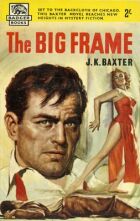
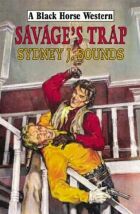
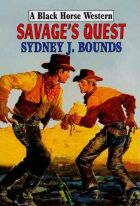
|
|
|
|

|
NEW
BLACK HORSE
WESTERN NOVELS
(Published by Robert Hale Ltd, London)
978
Buried Guns
|
Dan Claymaker
|
0 7090 8247 7
|
Moon Raiders
|
Skeeter Dodds
|
0
7090 8253 8
|
Just Call Me Clint
|
Chad Hammer
|
0
7090 8252 1
|
Zacchaeus Wolfe
|
P. McCormac |
0
7090 8243 9
|
Gold Country Ambush
|
George X. Holmes
|
0
7090 8257 6
|
| Dalton's Valley |
Ed Law
|
0
7090 8264 4
|
Montana Keep
|
Billy Hall
|
0
7090 8263 7
|
They Called Him Lightning
|
Mark Falcon
|
0
7090 8267 5
|
The Range Shootout
|
Carlton Youngblood
|
0
7090 8216 3
|
Brevet Ridge
|
Abe Dancer
|
0
7090 8275 0
|
Sons and Gunslicks
|
Chap O'Keefe |
0
7090 8068 8
|
The Long Trail
|
Corba Sunman |
0
7090 8127 2 |
Bluecoat Renegade
|
Dale Graham
|
0
7090 8166 1
|
Killer on the Loose
|
Elliot Long |
0
7090 8300 9
|
Texas Rendezvous
|
Gary Astill
|
0
7090 8302 3
|
| Hideout
|
Eugene Clifton
|
0
7090 8308 5
|
Flight from Felicidad
|
Steven Gray
|
0
7090 8315 3
|
Satan's Gun
|
Bill Williams
|
0
7090 8316 0
|
The Vernon Brand
|
Tom Benson |
0
7090 8317 7
|
The Laredo Gang
|
Alan Irwin |
0
7090 8318 4
|
Showdown at Trinidad
|
Daniel Rockfern
|
0 7090 7649 0
|
Hell Pass
|
Lance Howard
|
0 7090 8187 6
|
Both Sides of the Law
|
Hank J. Kirby
|
0 7090 8307 8
|
Kid Lobo
|
Clayton Nash
|
0 7090 8322 1
|
Gun Lords of Texas
|
Matt James
|
0 7090 8323 8
|
The Mavericks
|
Mark Bannerman
|
0 7090 8324 5
|
The Man They Couldn't Hang
|
Scott Connor
|
0 7090 8336 8
|
Dangling Noose
|
Jack Holt
|
0 7090 8337 5
|
Draw Down the Lightning
|
Ben Bridges
|
0 7090 8340 5
|
Silver Galore
|
John Dyson
|
0 7090 8355 1
|
|
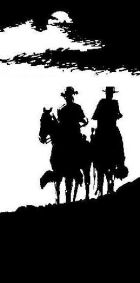
|
|
Ten new titles are
issued every month as BHWs -- tough, traditional or,
sometimes, off-trail. The brand caters for all tastes.
Black
Horse Westerns can be requested at public libraries, ordered at bookstores,
and bought online through the publisher's website, www.halebooks.com, or retailers including Blackwells, Amazon UK, WH Smith and VinersUK Books.
Trade inquiries
to: Combined Book Services,
Units I/K, Paddock Wood Distribution
Centre,
Paddock Wood, Tonbridge, Kent TN12 6UU.
Tel: (+44) 01892 837 171 Fax: (+44)
01892 837 272
Email: orders@combook.co.uk
|
|
|
|
|
|